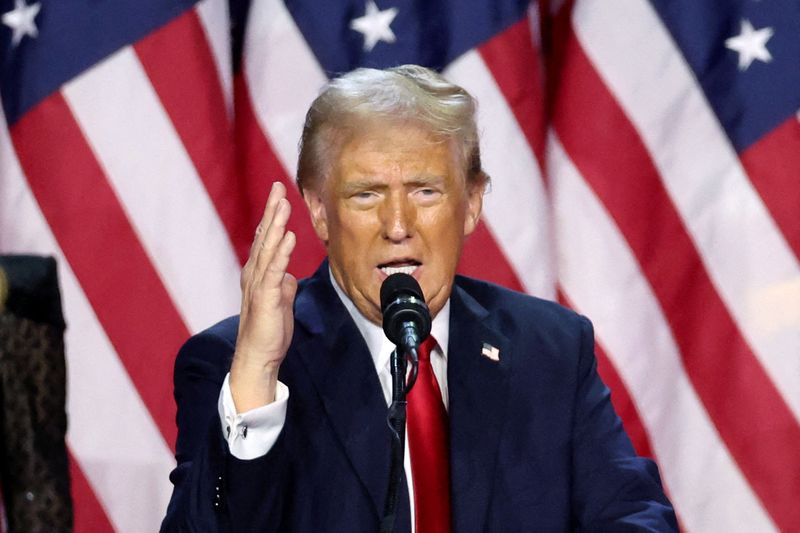Commodities
Factbox-What links have Trump and his allies maintained with oil-rich Gulf states?

DUBAI (Reuters) – Since leaving office in 2021, former President Donald Trump and several of his allies have continued to engage with the most powerful and wealthy Gulf countries, forging multi-million dollar business deals and engaging in quiet, behind-the-scenes diplomacy.
Below are some of the meetings and deals forged between Trump, who has claimed victory in the 2024 presidential election, his allies and the Gulf:
*Trump hosted Qatar’s ruling emir and the UAE president separately at his Mar-a-Lago residence and private club in September on the sidelines of their official visits.
*Several times since Trump left the White House, Jared Kushner, Trump’s son-in-law, discussed U.S.-Saudi diplomacy with Saudi Arabia’s crown prince and de-facto ruler Mohammed bin Salman, known as MBS. Kushner attended the 2022 soccer World Cup in Qatar.
*The Trump Organization, Trump’s company, has forged business deals with key allies in the region, spanning the UAE, Saudi Arabia and Oman.
*The Trump Organization announced in July it was teaming up with Saudi luxury international real estate developer Dar Global to build a Trump-branded tower in Dubai.
*London-listed Dar Global also announced in July it was working with the Trump Organization to develop a Trump Tower in Jeddah, Saudi Arabia.
*In 2022, Dar Global signed a deal with the Trump Organization to use the Trump brand for its $4 billion project in the Gulf state of Oman that includes a golf course, hotel and villas.
*Other key Trump allies have also maintained business ties with Gulf powers since leaving office in 2021.
*Dina Powell McCormick (NYSE:), who served various roles within the Trump administration including a stint as a deputy national security adviser, was among Wall Street veterans hired to work on Saudi Aramco (TADAWUL:)’s first IPO in 2019. Now an executive at merchant bank BDT & MSD Partners, she attended Saudi Arabia’s Future Investment Initiative conference in October 2024, a flagship event aimed at deal brokering.
*Ken Moelis (NYSE:), a one-time banker for Trump and the founder and chief executive of investment bank Moelis & Company, was also among those tapped to work on Saudi Aramco’s first IPO. Moelis attended Saudi Arabia’s Future Investment Initiative conference in October 2024.
*Steve Mnuchin, a former Goldman Sachs executive who was U.S. Treasury secretary during the Trump administration, has been a frequent visitor to Qatar, Saudi Arabia and the UAE since leaving office in 2021. The fund Mnuchin established, Liberty Strategic Capital, received backing from Abu Dhabi-based sovereign wealth fund Mubadala and SoftBank (TYO:)’s Vision Fund.
*Congressional investigators say Saudi Arabia has invested $2 billion in Jared Kushner’s private equity fund, Affinity Partners, which he set up after leaving the White House. Wealth funds in the UAE and Qatar have also invested hundreds of millions of dollars in the fund, according to The New York
Times.

*Eric Trump, one of the former president’s sons, told the Financial Times in July that the Trump Organization wanted to pursue more deals in the Middle East.
*Donald Trump Jr., the former president’s eldest son, traveled to Oman and Dubai in June.
Commodities
Oil prices rise; U.S. crude inventories plunge, Russia-Ukraine truce eyed
Commodities
India’s Reliance to stop buying Venezuelan oil over US tariffs, sources say
Commodities
Oil prices climb on Venezuela supply worries

 Forex3 years ago
Forex3 years agoForex Today: the dollar is gaining strength amid gloomy sentiment at the start of the Fed’s week

 Forex3 years ago
Forex3 years agoUnbiased review of Pocket Option broker

 Forex3 years ago
Forex3 years agoDollar to pound sterling exchange rate today: Pound plummeted to its lowest since 1985

 Forex3 years ago
Forex3 years agoHow is the Australian dollar doing today?

 Cryptocurrency3 years ago
Cryptocurrency3 years agoWhat happened in the crypto market – current events today

 World3 years ago
World3 years agoWhy are modern video games an art form?

 Commodities3 years ago
Commodities3 years agoCopper continues to fall in price on expectations of lower demand in China

 Economy3 years ago
Economy3 years agoCrude oil tankers double in price due to EU anti-Russian sanctions























